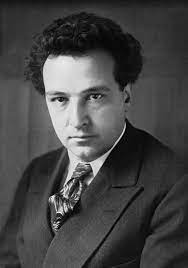This Week in Classical Music: March 6, 2023. Honegger. The always popular Maurice Ravel was born this week, on March 7th of 1875. And so were Carl Philipp Emanuel Bach, probably  the most important composer among Johann Sebastian’s sons (on March 8th of 1714); Carlo Gesualdo, the brooding murderer and composer of huge talent (on the same day in 1566); Josef Mysliveček, a Czech friend of Mozart’s (on March 9th of 1737); and Samuel Barber, one of the most popular American composers of the 20th century (on March 9th of 1910). All of them we’ve written about on many occasions. One composer whom we’ve mentioned often but, quite undeservedly, only in passing, is Arthur Honegger, a Swiss and unusual member of Les Six.
the most important composer among Johann Sebastian’s sons (on March 8th of 1714); Carlo Gesualdo, the brooding murderer and composer of huge talent (on the same day in 1566); Josef Mysliveček, a Czech friend of Mozart’s (on March 9th of 1737); and Samuel Barber, one of the most popular American composers of the 20th century (on March 9th of 1910). All of them we’ve written about on many occasions. One composer whom we’ve mentioned often but, quite undeservedly, only in passing, is Arthur Honegger, a Swiss and unusual member of Les Six.
Honegger was born on March 10th of 1892 in the French port city of Le Havre to Swiss parents (there was an old Swiss colony in the city). As a child, Honegger studied the violin and harmony in Le Havre and then, for two years, in Zurich. At the age of 18, while still living in Zurich, he enrolled in the Paris Conservatory; he commuted there by train twice weekly. In Paris Honegger studied with Charles-Marie Widor, the famous organist and composer, and Vincent d'Indy. In 1913 Honegger settled in Montmartre, where he lived for the rest of his life. While at the Conservatory, he met Germaine Tailleferre, Georges Auric, Darius Milhaud, all future members of Les Six (Milhaud became his closest friend), and Jacques Ibert, with whom he would later collaborate on two pieces. In 1926 Honegger married a fellow pianist Andrée Vaurabourg. Their married life was unusual: Honegger required solitude to compose, so Andrée resided with her mother, while Honegger visited her every day for lunch. They lived apart for the rest of their married life, except for a period following Vaurabourg’s car accident, when Honegger took care of her, and at the end of Honegger’s life. Despite this arrangement, they had a daughter who was born in 1932. Vaurabourg was Honegger’s most trusted musical advisor; an excellent pianist, she was also a prominent teacher: among her students was Pierre Boulez.
During WWII Honegger remained in Paris and taught at the Ecole Normale de Musique. Depressed during the war, he further suffered from heart problems (a heart attack in 1947 almost killed him). He was in poor health for the rest of his life and died in November of 1955, the first of the Les Six. And speaking of Les Six, it was never a unified group, and esthetically, a serious-minded Honegger, mostly interested in large-form compositions like operas and musical dramas, was an odd man out. What kept them all together was stimulating companionship and appreciation of each other’s talent.
A composition that brought Honegger international fame was a 27-movement incidental score to a biblical drama Le roi David. Among his most popular pieces is Pacific 231, inspired by the sounds of a steam locomotive (Honegger was a big train enthusiast, he also loved fast cars and rugby). Here’s his last symphony, no. 5, subtitled “Di tre re” (or Of the three Ds, “re” is note D in the French notation. This note is played at the end of each movement). The Danish National Radio Symphony Orchestra is conducted by Neeme Järvi.
| Source: | https://www.classicalconnect.com/node/13896 |
| Website: | Classical Connect |